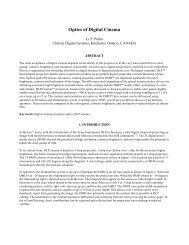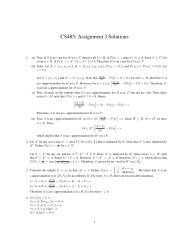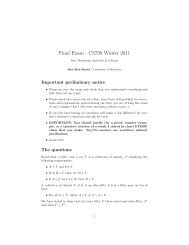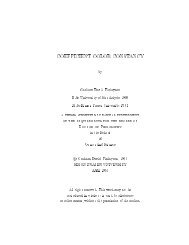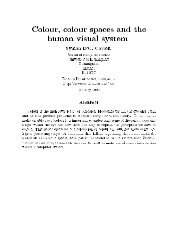Past Midterm and Exam Questions (PDF) - Student.cs.uwaterloo.ca ...
Past Midterm and Exam Questions (PDF) - Student.cs.uwaterloo.ca ...
Past Midterm and Exam Questions (PDF) - Student.cs.uwaterloo.ca ...
Create successful ePaper yourself
Turn your PDF publications into a flip-book with our unique Google optimized e-Paper software.
CS488/688 Introduction to Computer Graphi<strong>cs</strong> 37<br />
Light<br />
Eye<br />
Eye<br />
Light<br />
1. Assume the plane/line only has a diffuse material component. Mark with a ’D’ on the figure<br />
where the plane/line will appear brightest to the viewer.<br />
2. Assume instead that the plane/line only has a specular material component. Mark with an<br />
’S’ on the figure where the plane/line will appear brightest to the viewer.<br />
3. Suppose now the light has r 2 attenuation. How will the lo<strong>ca</strong>tion of the brightest point change<br />
if the plane/line only has a diffuse material component?<br />
4. Again suppose the light has r 2 attenuation. How will the lo<strong>ca</strong>tion of the brightest point<br />
change if the plane/line only has a specular material component?<br />
15.2 Phong Lighting <strong>and</strong> Gouraud Shading [Last Used: Spring 1992 Final]<br />
Answer the following parts, giving details <strong>and</strong>/or reasons for all answers.<br />
(a) The shading intensity at any given point on a surface is, in general, comprised of three contributions,<br />
each of which corresponds to a distinct physi<strong>ca</strong>l phenomenon. List all three, stating<br />
how they are computed in terms of the appropriate vectors (which you should define). In<br />
particular, what is the formula for the “reflection vector”?<br />
(b) How is any interior pixel of a triangle, indi<strong>ca</strong>ted below by P , to be coloured according to the<br />
Gouraud method? In which spaces (object, world, perspective, or screen) could one compute<br />
the normals? In which spaces could one compute the shades? In which spaces should the<br />
normals not be computed? In which spaces should the shades not be computed? What<br />
information must the pixel-filling algorithm have in order to assign pixel shades to the edges<br />
<strong>and</strong> interior of the screen projection of a polygon?<br />
(c) Answer all of the questions in part (b) for the Phong method of assigning pixel colours.





